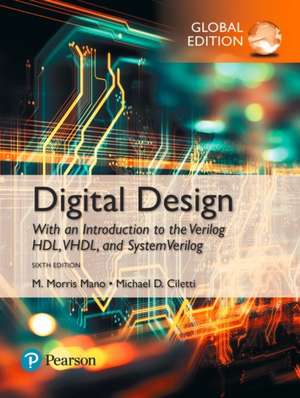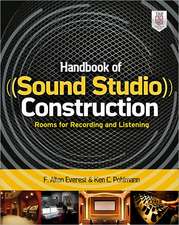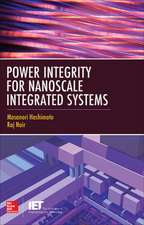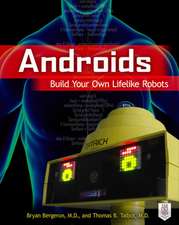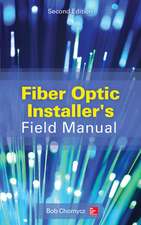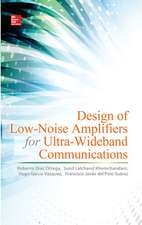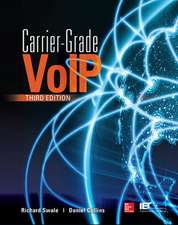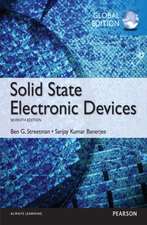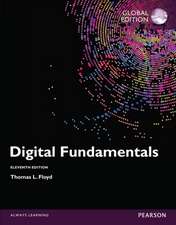Digital Design, Global Edition
Autor M. Morris Mano, Michael Cilettien Limba Engleză Paperback – 13 iul 2018
A clear and accessible approach to teaching the basic tools, concepts, and applications of digital design.
A modern update to a classic, authoritative text, Digital Design, 6th Edition teaches the fundamental concepts of digital design in a clear, accessible manner. The text presents the basic tools for the design of digital circuits and provides procedures suitable for a variety of digital applications. Like the previous editions, this edition of Digital Design supports a multimodal approach to learning, with a focus on digital design, regardless of language. Recognizing that three public-domain languages?Verilog, VHDL, and SystemVerilog?all play a role in design flows for today's digital devices, the 6th Edition offers parallel tracks of presentation of multiple languages, but allows concentration on a single, chosen language.
Preț: 562.54 lei
Preț vechi: 646.59 lei
-13% Nou
Puncte Express: 844
Preț estimativ în valută:
107.66€ • 111.98$ • 88.88£
107.66€ • 111.98$ • 88.88£
Carte disponibilă
Livrare economică 24 martie-07 aprilie
Livrare express 08-14 martie pentru 47.28 lei
Preluare comenzi: 021 569.72.76
Specificații
ISBN-13: 9781292231167
ISBN-10: 1292231165
Pagini: 720
Dimensiuni: 182 x 236 x 25 mm
Greutate: 0.98 kg
Ediția:6 ed
Editura: Pearson Education
ISBN-10: 1292231165
Pagini: 720
Dimensiuni: 182 x 236 x 25 mm
Greutate: 0.98 kg
Ediția:6 ed
Editura: Pearson Education
Notă biografică
M. Morris Mano is an Emeritus Professor of Computer Engineering at the California State University, Los Angeles. His notable works include the Mano Machine, i.e. a theoretical computer that contains a central processing unit, random access memory, and an input-output bus. M. Morris Mano has authored numerous books in the area of digital circuits that are known for teaching the basic concepts of digital logic circuits in a clear, accessible manner. His books for the introductory digital design course, Logic and Computer Design Fundamentals and Digital Design, continue to be two of the most widely used texts around the world.
Michael Ciletti is an Emeritus Professor of Electrical and Computer Engineering at the University of Colorado, Colorado Springs. An early advocate of including HDL-based design methodology in the curriculum, he pioneered and developed the offering of several courses using Verilog, VHDL, FPGAs and standard cell based hardware implementations for design, testing, and synthesis of VLSI devices. His consulting work has ranged from processor design to providing expert witness testimony in cases involving HDLs. He has developed and presented courses for industry in The United States, Asia, and Europe. His widely-adopted textbooks have promoted the use of the now-standard Verilog HDL and encouraged adoption of HDL-based design practice in logic design and computer science curricula. Ciletti resides in Colorado Springs, CO, where he pursues a strong interest in landscape photography.
Michael Ciletti is an Emeritus Professor of Electrical and Computer Engineering at the University of Colorado, Colorado Springs. An early advocate of including HDL-based design methodology in the curriculum, he pioneered and developed the offering of several courses using Verilog, VHDL, FPGAs and standard cell based hardware implementations for design, testing, and synthesis of VLSI devices. His consulting work has ranged from processor design to providing expert witness testimony in cases involving HDLs. He has developed and presented courses for industry in The United States, Asia, and Europe. His widely-adopted textbooks have promoted the use of the now-standard Verilog HDL and encouraged adoption of HDL-based design practice in logic design and computer science curricula. Ciletti resides in Colorado Springs, CO, where he pursues a strong interest in landscape photography.
Cuprins
Preface
1 Digital Systems and Binary Numbers
1.1 Digital Systems
1.2 Binary Numbers
1.3 Number-Base Conversions
1.4 Octal and Hexadecimal Numbers
1.5 Complements of Numbers
1.6 Signed Binary Numbers
1.7 Binary Codes
1.8 Binary Storage and Registers
1.9 Binary Logic
2 Boolean Algebra and Logic Gates
2.1 Introduction
2.2 Basic Definitions
2.3 Axiomatic Definition of Boolean Algebra
2.4 Basic Theorems and Properties of Boolean Algebra
2.5 Boolean Functions
2.6 Canonical and Standard Forms
2.7 Other Logic Operations
2.8 Digital Logic Gates
2.9 Integrated Circuits
3 Gate-Level Minimization
3.1 Introduction
3.2 The Map Method
3.3 Four-Variable K-Map
3.4 Product-of-Sums Simplification
3.5 Don't-Care Conditions
3.6 NAND and NOR Implementation
3.7 Other Two-Level Implementations
3.8 Exclusive-OR Function
3.9 Hardware Description Languages (HDLs)
4 Combinational Logic
4.1 Introduction
4.2 Combinational Circuits
4.3 Analysis of Combinational Circuits
4.4 Design Procedure
4.5 Binary Adder-Subtractor
4.6 Decimal Adder
4.7 Binary Multiplier
4.8 Magnitude Comparator
4.9 Decoders
4.10 Encoders
4.11 Multiplexers
4.12 HDL Models of Combinational Circuits
5 Synchronous Sequential Logic
5.1 Introduction
5.2 Sequential Circuits
5.3 Storage Elements: Latches
5.4 Storage Elements: Flip-Flops
5.5 Analysis of Clocked Sequential Circuits
5.6 Synthesizable HDL Models of Sequential Circuits
5.7 State Reduction and Assignment
5.8 Design Procedure
6 Registers and Counters
6.1 Registers
6.2 Shift Registers
6.3 Ripple Counters
6.4 Synchronous Counters
6.5 Other Counters
6.6 HDL Models of Registers and Counters
7 Memory and Programmable Logic
7.1 Introduction
7.2 Random-Access Memory
7.3 Memory Decoding
7.4 Error Detection and Correction
7.5 Read-Only Memory
7.6 Programmable Logic Array
7.7 Programmable Array Logic
7.8 Sequential Programmable Devices
8 Design at the Register Transfer Level
8.1 Introduction
8.2 Register Transfer Level (RTL) Notation
8.3 RTL descriptions VERILOG (Edge- and Level-Sensitive Behaviors)
8.4 Algorithmic State Machines (ASMs)
8.5 Design Example (ASMD Chart)
8.6 HDL Description of Design Example
8.7 Sequential Binary Multiplier
8.8 Control Logic
8.9 HDL Description of Binary Multiplier
8.10 Design with Multiplexers
8.11 Race-Free Design (Software Race Conditions)
8.12 Latch-Free Design (Why Waste Silicon?)
8.13 System Verilog-An Introduction
9 Laboratory Experiments with Standard ICs and FPGAs
9.1 Introduction t
1 Digital Systems and Binary Numbers
1.1 Digital Systems
1.2 Binary Numbers
1.3 Number-Base Conversions
1.4 Octal and Hexadecimal Numbers
1.5 Complements of Numbers
1.6 Signed Binary Numbers
1.7 Binary Codes
1.8 Binary Storage and Registers
1.9 Binary Logic
2 Boolean Algebra and Logic Gates
2.1 Introduction
2.2 Basic Definitions
2.3 Axiomatic Definition of Boolean Algebra
2.4 Basic Theorems and Properties of Boolean Algebra
2.5 Boolean Functions
2.6 Canonical and Standard Forms
2.7 Other Logic Operations
2.8 Digital Logic Gates
2.9 Integrated Circuits
3 Gate-Level Minimization
3.1 Introduction
3.2 The Map Method
3.3 Four-Variable K-Map
3.4 Product-of-Sums Simplification
3.5 Don't-Care Conditions
3.6 NAND and NOR Implementation
3.7 Other Two-Level Implementations
3.8 Exclusive-OR Function
3.9 Hardware Description Languages (HDLs)
4 Combinational Logic
4.1 Introduction
4.2 Combinational Circuits
4.3 Analysis of Combinational Circuits
4.4 Design Procedure
4.5 Binary Adder-Subtractor
4.6 Decimal Adder
4.7 Binary Multiplier
4.8 Magnitude Comparator
4.9 Decoders
4.10 Encoders
4.11 Multiplexers
4.12 HDL Models of Combinational Circuits
5 Synchronous Sequential Logic
5.1 Introduction
5.2 Sequential Circuits
5.3 Storage Elements: Latches
5.4 Storage Elements: Flip-Flops
5.5 Analysis of Clocked Sequential Circuits
5.6 Synthesizable HDL Models of Sequential Circuits
5.7 State Reduction and Assignment
5.8 Design Procedure
6 Registers and Counters
6.1 Registers
6.2 Shift Registers
6.3 Ripple Counters
6.4 Synchronous Counters
6.5 Other Counters
6.6 HDL Models of Registers and Counters
7 Memory and Programmable Logic
7.1 Introduction
7.2 Random-Access Memory
7.3 Memory Decoding
7.4 Error Detection and Correction
7.5 Read-Only Memory
7.6 Programmable Logic Array
7.7 Programmable Array Logic
7.8 Sequential Programmable Devices
8 Design at the Register Transfer Level
8.1 Introduction
8.2 Register Transfer Level (RTL) Notation
8.3 RTL descriptions VERILOG (Edge- and Level-Sensitive Behaviors)
8.4 Algorithmic State Machines (ASMs)
8.5 Design Example (ASMD Chart)
8.6 HDL Description of Design Example
8.7 Sequential Binary Multiplier
8.8 Control Logic
8.9 HDL Description of Binary Multiplier
8.10 Design with Multiplexers
8.11 Race-Free Design (Software Race Conditions)
8.12 Latch-Free Design (Why Waste Silicon?)
8.13 System Verilog-An Introduction
9 Laboratory Experiments with Standard ICs and FPGAs
9.1 Introduction t
